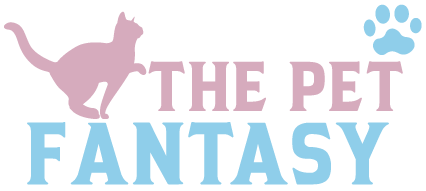
Bengal cats are renowned for their boundless energy, sharp intelligence, and strong hunting instincts, making them a unique and engaging breed. To keep these active felines happy and healthy, creating a hunting game for Bengal cat indoors is an excellent way to satisfy their natural predatory drive while providing mental and physical stimulation. This comprehensive guide will walk you through the steps to design engaging indoor hunting games, recommend tools and toys, and offer tips to ensure your Bengal thrives in a stimulating environment.
Why Hunting Games Are Essential for Bengal Cats
Bengal cats, with their ancestry tied to the wild Asian leopard cat, possess a strong instinct to hunt, stalk, and pounce. In an indoor setting, where access to natural prey is absent, these instincts can lead to boredom or destructive behaviors if not properly channeled. A well-designed hunting game for Bengal cat indoors offers numerous benefits:
Mental Stimulation: Engages their problem-solving skills and keeps their minds sharp.
Physical Exercise: Promotes healthy activity levels, preventing obesity and related health issues.
Behavioral Health: Reduces stress, anxiety, and destructive behaviors like scratching or chewing.
Instinct Fulfillment: Mimics the thrill of the hunt, satisfying their predatory nature.
Bonding Opportunity: Interactive games strengthen the bond between you and your Bengal.
By incorporating hunting games into your cat’s routine, you create a dynamic indoor environment that caters to their unique needs.
Understanding Your Bengal’s Hunting Instincts
Before designing a hunting game, it’s helpful to understand the natural behaviors that drive Bengals:
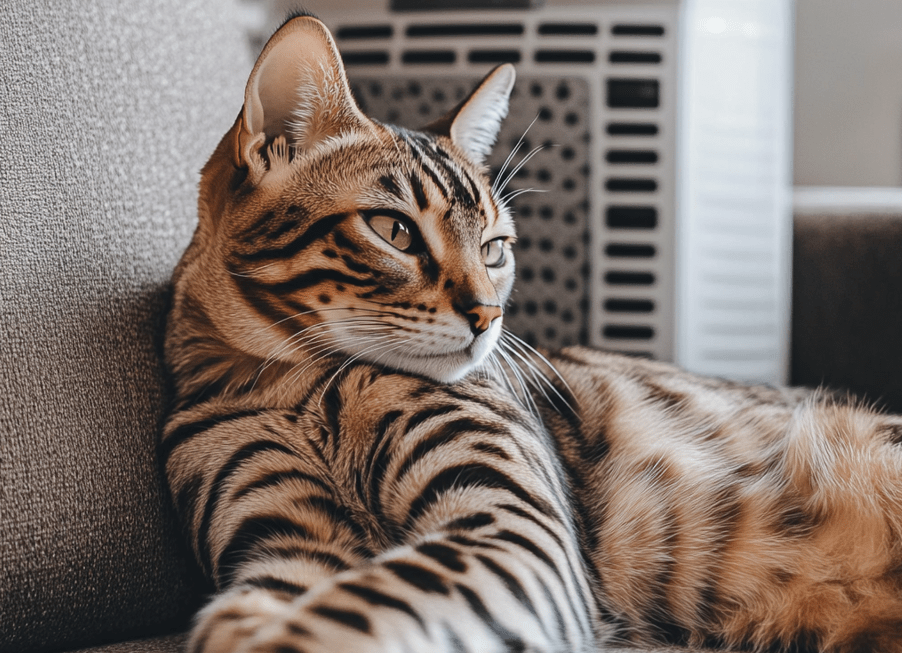
Stalking: Bengals love to creep and observe “prey” before striking.
Pouncing: Their agile bodies are built for quick, precise leaps.
Chasing: Fast-moving objects trigger their chase response.
Problem-Solving: Bengals enjoy challenges that require figuring out how to access hidden objects.
A successful hunting game for Bengal cat indoors should incorporate these elements to keep them engaged and fulfilled.
Benefits of Indoor Hunting Games for Bengal Cats
Hunting games provide more than just entertainment. Here are the key advantages:
Prevents Boredom: Keeps your Bengal occupied, reducing the likelihood of destructive behaviors.
Supports Physical Health: Encourages running, jumping, and climbing, promoting cardiovascular fitness.
Enhances Cognitive Skills: Puzzle-based games challenge their intelligence, keeping their minds active.
Reduces Stress: Engaging activities lower anxiety and promote relaxation.
Cost-Effective Fun: Many games can be created with household items, saving money on toys.
How to Create a Hunting Game for Your Bengal Cat Indoors: A Step-by-Step Guide
Designing an effective hunting game requires creativity and an understanding of your Bengal’s preferences. Follow these steps to create a stimulating indoor experience:
Step 1: Assess Your Space
Evaluate your home to identify safe, cat-friendly areas for the game. Consider:
Open Spaces: Living rooms or hallways for chasing and pouncing.
Vertical Areas: Cat trees, shelves, or furniture for climbing and stalking.
Hiding Spots: Boxes, tunnels, or furniture for concealing “prey.”
Safety: Remove hazards like fragile objects or toxic plants.
Ensure the space allows for active play without risking injury or damage.
Step 2: Gather Materials
You don’t need expensive toys to create a hunting game. Use a mix of store-bought and DIY items, such as:
Toys: Feather wands, laser pointers, balls, or stuffed mice.
Household Items: Cardboard boxes, paper bags, or crumpled paper.
Treats: Small, healthy treats to reward “successful hunts.”
Puzzle Feeders: Treat-dispensing toys or DIY puzzle boxes.
Scented Items: Catnip or silvervine to enhance engagement.
Rotate these items to keep the game fresh and exciting.
Step 3: Design the Hunting Game
Create a game that mimics a real hunt by incorporating stalking, chasing, and capturing elements. Here are three game ideas:
Game 1: Treasure Hunt
Objective: Your Bengal searches for hidden “prey” (toys or treats) around the house.
Setup: Hide small toys, treats, or catnip-stuffed items in various locations (e.g., under rugs, inside boxes, or on shelves).
How to Play:
1.Start with easy hiding spots to build confidence.
2.Guide your Bengal with verbal cues or a laser pointer to the first item.
3.Gradually increase difficulty by hiding items in higher or less obvious places.
Why It Works: Engages scent-tracking and problem-solving skills, mimicking a real hunt.
Game 2: Obstacle Course Chase
Objective: Your Bengal navigates an obstacle course to “catch” moving prey.
Setup: Create a course using furniture, tunnels, boxes, or cat trees. Attach a feather wand or string toy to drag through the course.
How to Play:
1.Move the toy slowly to encourage stalking, then speed up to trigger chasing.
2.Vary the path each time to keep it unpredictable.
3.Reward with treats or praise after a successful “catch.”
Why It Works: Combines physical exercise with the thrill of pursuit.
Game 3: Puzzle Hunt
Objective: Your Bengal solves puzzles to access hidden treats or toys.
Setup: Use a store-bought puzzle feeder or make a DIY version with a box, toilet paper rolls, or muffin tins. Place treats or small toys inside.
How to Play:
1.Start with simple puzzles (e.g., treats in an open box).
2.Progress to complex setups (e.g., treats in covered compartments).
3.Encourage exploration with verbal cues or tapping the puzzle.
Why It Works: Challenges cognitive skills and rewards persistence.
Step 4: Introduce the Game
Present the game in an exciting way to spark your Bengal’s interest:
Use Movement: Wiggle toys or drag strings to mimic prey.
Add Scent: Rub catnip on toys or hide treats to engage their nose.
Start Simple: Begin with easy tasks to build confidence, then increase difficulty.
Be Interactive: Participate actively to make the game more engaging and strengthen your bond.
Step 5: Rotate and Vary Games
To prevent boredom, rotate game types and materials every 1-2 weeks. For example:
Week 1: Treasure Hunt with hidden toys.
Week 2: Obstacle Course Chase with a feather wand.
Week 3: Puzzle Hunt with a new DIY feeder.
Vary hiding spots, toy types, and rewards to maintain novelty.
Step 6: Observe and Adapt
Watch how your Bengal responds to each game. If they lose interest, try:
1.Changing the time of day (Bengals are often most active at dawn or dusk).
2.Introducing new toys or scents.
3.Adjusting the difficulty to match their skill level.
Tailor the game to your cat’s unique preferences for maximum engagement.
Best Tools and Toys for Indoor Hunting Games
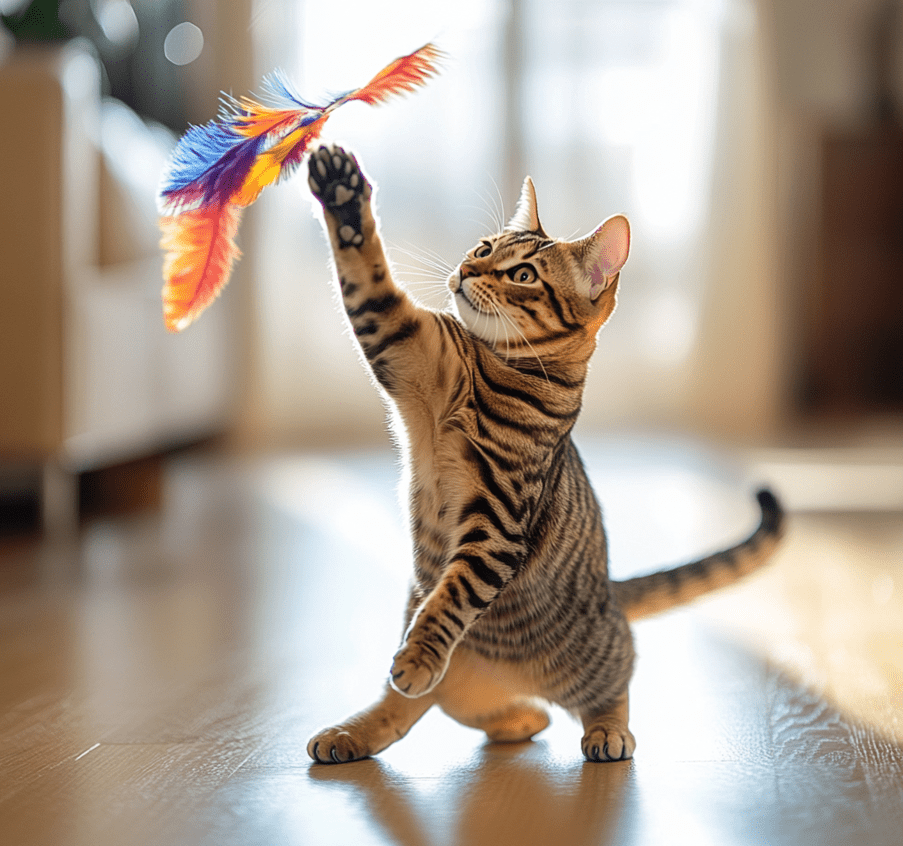
Choosing the right tools enhances the effectiveness of your hunting game for Bengal cat indoors. Here are top recommendations:
1. Feather Wand Toys
Example: Da Bird Feather Teaser.
Why It’s Great: Mimics bird-like movements, triggering stalking and pouncing.
Tip: Rotate attachments (feathers, ribbons) to keep it fresh.
2. Laser Pointers
Example: PetSafe Bolt Laser Toy.
Why It’s Great: Encourages high-speed chasing and sharpens focus.
Tip: Always end with a tangible “catch” (e.g., a toy) to avoid frustration.
3. Puzzle Feeders
Example: Trixie Activity Fun Board.
Why It’s Great: Challenges cognitive skills and rewards with treats.
Tip: Vary treat types to maintain interest.
4. Interactive Balls
Example: Petstages Tower of Tracks.
Why It’s Great: Encourages solo play with spinning balls.
Tip: Hide balls in different locations for a treasure hunt twist.
5. DIY Toys
Examples: Cardboard boxes with cutouts, crumpled paper balls, or toilet paper rolls.
Why It’s Great: Budget-friendly and customizable.
Tip: Add catnip or treats to increase appeal.
6. Cat Tunnels
Example: Kitty City Pop-Up Tunnel.
Why It’s Great: Provides hiding and stalking opportunities.
Tip: Move the tunnel to different rooms for variety.
Common Mistakes to Avoid
To ensure your hunting game is successful, steer clear of these pitfalls:
Overcomplicating Games: Start simple to avoid overwhelming your Bengal.
Using the Same Setup Repeatedly: Lack of variety leads to boredom.
Ignoring Safety: Ensure toys are durable and free of small parts that could be swallowed.
Neglecting Interactive Play: Bengals thrive on human interaction, so balance solo and interactive games.
Inconsistent Scheduling: Play at consistent times to align with your cat’s natural rhythms.
Additional Tips for a Stimulating Indoor Environment
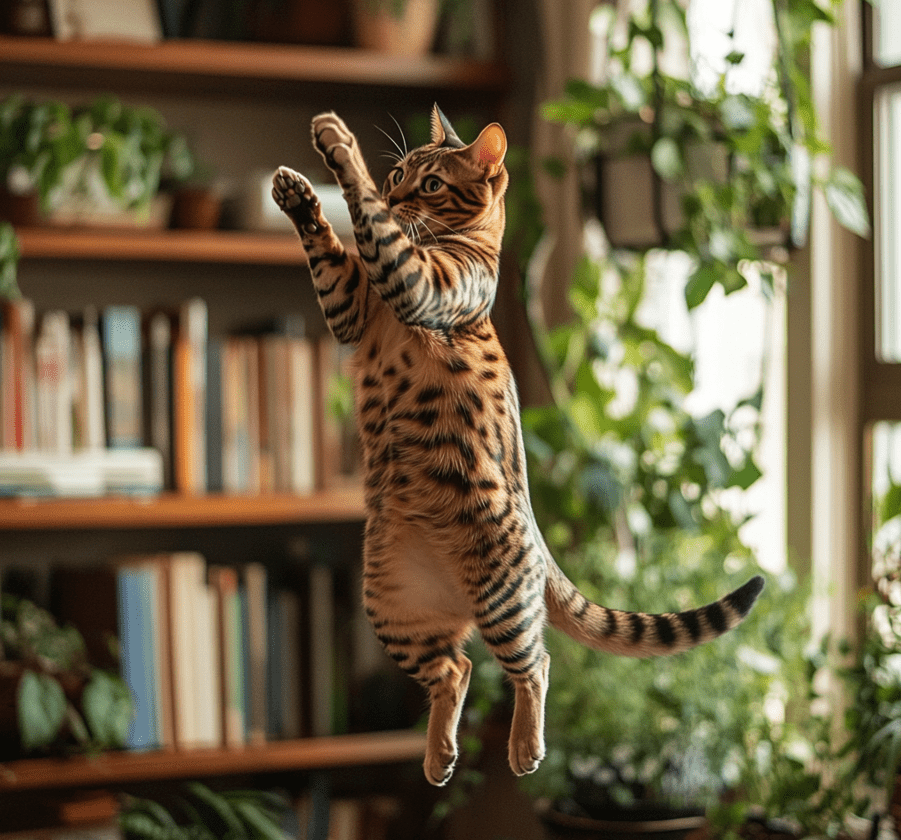
Hunting games are most effective when paired with a cat-friendly environment. Consider these strategies:
Enrich the Space
Cat Trees: Provide vertical spaces for stalking and jumping.
Window Perches: Allow bird-watching to stimulate hunting instincts.
Hiding Spots: Boxes or tunnels for “ambush” play.
Schedule Play Sessions
Dedicate 15-30 minutes daily to interactive hunting games, ideally during your Bengal’s peak activity times (morning and evening).
Incorporate Training
Use hunting games to teach tricks like “fetch” or “jump.” This engages their mind and reinforces positive behaviors.
Monitor Health
If your Bengal shows disinterest in games, it could signal health issues. Consult a veterinarian to rule out underlying problems.
How Often Should You Play Hunting Games?
The frequency and duration of hunting games depend on your Bengal’s energy level:
High-Energy Bengals: 2-3 sessions daily, 15-20 minutes each.
Moderate-Energy Bengals: 1-2 sessions daily, 10-15 minutes each.
Senior Bengals: 1 session daily, 5-10 minutes, with gentler games.
Adjust based on your cat’s response and lifestyle.
Signs Your Bengal Is Engaged
A successful hunting game will result in a happy, active Bengal. Look for:
1.Enthusiastic chasing, pouncing, or stalking.
2.Increased vocalization during play (a sign of excitement).
3.Reduced destructive behaviors like scratching furniture.
4.Healthy appetite and energy levels.
If engagement wanes, tweak the game or introduce new elements.
Conclusion
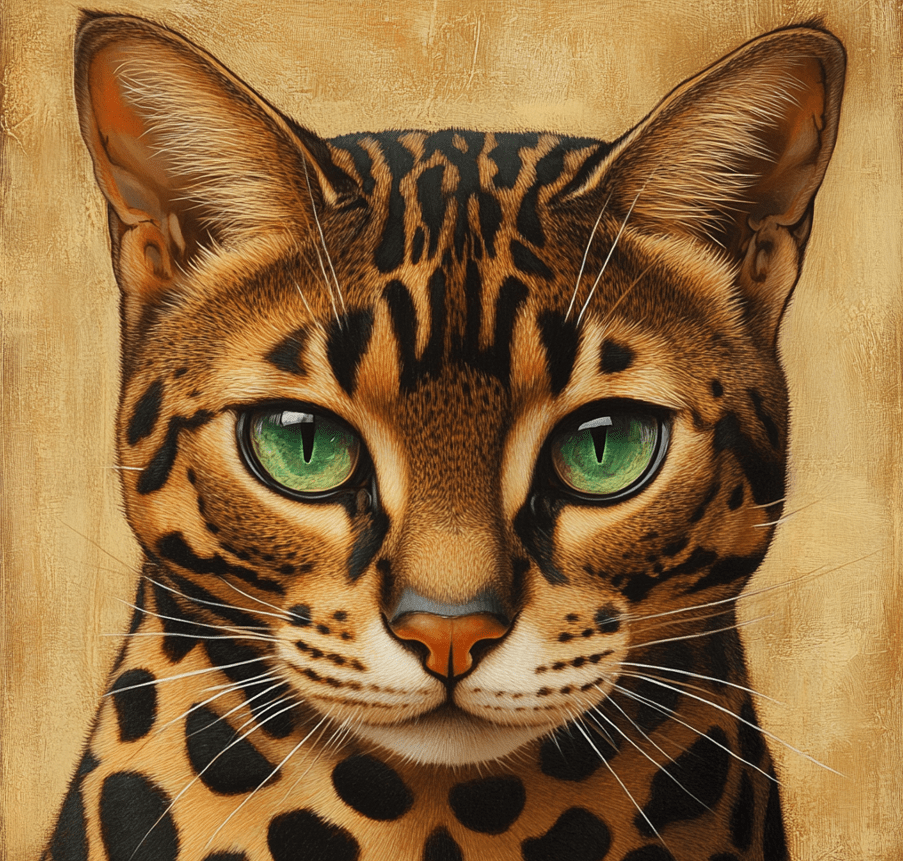
Creating a hunting game for Bengal cat indoors is a fun and effective way to keep your feline companion engaged, healthy, and happy. By tapping into their natural instincts with creative games like treasure hunts, obstacle courses, and puzzle challenges, you provide the mental and physical stimulation they crave. With the right tools, a thoughtful approach, and regular variety, you’ll transform your home into a playground that satisfies your Bengal’s wild side.
